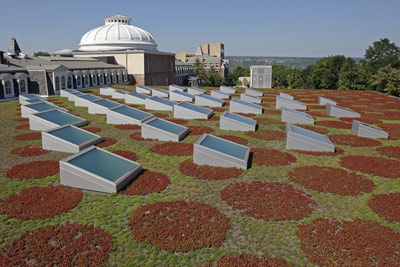Milstein Hall earns LEED Gold certification
By Aaron Goldweber

Milstein Hall, internationally recognized for its design since opening in August 2011, has received LEED Gold certification from the U.S. Green Building Council. LEED is the nation's preeminent recognition for the design, construction and operation of high-performance green buildings.
The 47,000-square-foot Milstein Hall is an addition to Cornell's College of Architecture, Art and Planning and provides studio space for 200 students, a gallery, critique spaces and a 250--seat auditorium as it physically connects the historic Rand and Sibley halls. Milstein Hall received 40 out of 69 possible LEED points, scoring exceptionally well for its "innovation and design" and "water efficiency."
"With LEED Gold certification, Milstein Hall is helping to underscore Cornell University's continued commitment to the Green Buildings Initiatives supported at the highest levels of university leadership," says Kyu-Jung Whang, vice president for facilities services. "For a building with such marvelous architecture to be able to add to Cornell's sustainability efforts, we, as an institution, can't be prouder."
Designed by OMA, the building features a 24,000-square-foot green roof planted with drought-tolerant sedum. Dozens of north-facing skylights add further efficiency to the award-winning lighting design. Cornell's innovative Lake Source Cooling system is employed through chilled beams, reducing the need for traditional HVAC systems. Radiant heating through the concrete floor slabs and abundant floor-to-ceiling windows of high-performance glass add to the building's comfort and ambiance.
"This is certainly wonderful news. Attaining gold certification on this very special building demonstrates our objective to build meaningful buildings that are beautiful and responsible to our environment," says University Architect Gilbert Delgado.
Many of the building's interior surfaces integrate structural and mechanical systems, thereby reducing the need for additional materials, and concrete foundation walls and structural steel are as vital to the design as they are to the engineering of the building.
Nearly 22 percent of Milstein Hall's building materials were manufactured using recycled sources. During construction, workers recycled more than 85 percent of waste -- nearly 390 tons -- that would have otherwise been dumped in landfills.
Other LEED Gold-rated buildings at Cornell include the Combined Heat and Power Plant offices (2011), Physical Sciences Building (2010), Riley-Robb Hall biofuels research lab (2010) and Weill Hall (2008).
Media Contact
Get Cornell news delivered right to your inbox.
Subscribe